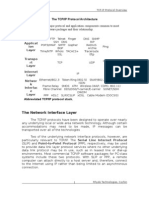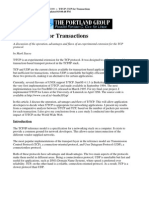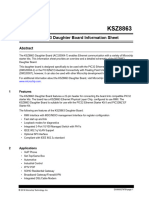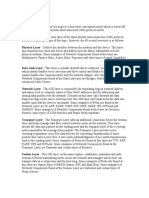RFC 1086
RFC 1086
Uploaded by
NickyNETCopyright:
Available Formats
RFC 1086
RFC 1086
Uploaded by
NickyNETOriginal Title
Copyright
Available Formats
Share this document
Did you find this document useful?
Is this content inappropriate?
Copyright:
Available Formats
RFC 1086
RFC 1086
Uploaded by
NickyNETCopyright:
Available Formats
Network Working Group J.
Onions
Request for Comments: 1086 Nottingham
M. Rose
TWG
December 1988
ISO-TP0 bridge between TCP and X.25
Status of this Memo
This memo proposes a standard for the Internet community. Hosts on
the Internet that choose to implement ISO TP0 transport connectivity
between TCP and X.25 based hosts are expected to experiment with this
proposal. TCP port 146 is reserved for this proposal. Distribution
of this memo is unlimited and comments are highly encouraged.
Introduction
This memo specifies a protocol that is used to bridge ISO TP0 packets
between X.25 and TCP networks. This technique is useful when
interconnecting a DDN IP internet to an X.25 subnetwork. This is not
a "magic bullet" solution to the DDN/ISO interoperability problem.
Rather, if one is running higher-layer ISO protocols in both networks
(namely ISO TP0), then a TP0 bridge can be used to achieve
connectivity.
The protocol itself is fairly simple as the method of operation for
running TP0 over the TCP and X.25 protocols have previously been
defined. A bridge offering ISO-TP0 gateway services simply applies
both methods as appropriate. The protocol works by TP0/TCP hosts
"registering" an X.25 subaddress (and corresponding TCP port/IP
address) with the bridge. TP0/X.25 hosts use the standard method for
establishing, maintaining, and releasing connections. When a
connection is established, the bridge establishes the corresponding
TCP connection and simply shuffles TP0 packets between the two. When
a TP0/TCP host initiates a connection, it establishes a TCP
connection to the bridge using port number 146 and communicates the
desired X.25 address. The bridge establishes a connection to the
native X.25 host and simply shuffles TP0 packets between the two.
1. Introduction and Motivation
The migratory protocol described in [RFC1006] makes possible the
transmission of TP0 packets between hosts on TCP/IP internets. With
the addition of a small protocol converter, a TCP/IP host can be made
to appear in the X.25 addressing space and be able to accept and make
Onions & Rose [Page 1]
RFC 1086 ISO-TP0 bridge between TCP and X.25 December 1988
connections using the TP0 protocol.
This procedure is particularly useful in the following cases:
1. A host on an IP based internet can communicate with hosts on
X.25 based networks providing the hosts are running ISO protocols.
This also assumes a friendly gateway willing to run the actual TP0
bridge and make available to the IP host part of its X.25 address
space.
2. A site having sparse connections to an X.25 network and using
a TCP/IP based local area network for local communications. In
this case all hosts on the LAN can have access to hosts on the
X.25 network running ISO TP0.
Pictorially, this memo describes interoperation in the following
environment:
+---------------------------------+
| |
| +-----------------------------------+
| +----+ | +----+ | +----+ |
| | | | | | | | | |
| | +-----------|-----+ +--------------+ | |
| | | TP0 | | | | TP0 | | |
| +----+ | +----+ | +----+ |
| TCP Host | Bridge Host| X.25 Host |
| | | |
| | | |
| | | |
+-------------------|-------------+ |
TCP/IP Network | |
| |
+-----------------------------------+
X.25 Network
2. Definitions and Philosophy
Some modest terminology and philosophy is introduced to aid
readability and stir interest.
The ISO Transport Service (TS) provides a reliable, packet-stream to
its users [ISO8072]. The ISO Transport Protocol (TP) implements this
service [ISO8073]. There are five classes of this protocol. The
class is selected on the basis of the services offered by the
underlying network service. Transport class 0 (TP0) is used when the
network service offered is connection-oriented and error-detecting.
Onions & Rose [Page 2]
RFC 1086 ISO-TP0 bridge between TCP and X.25 December 1988
As should be expected, TP0 is a rather simple protocol, since the
underlying network service actually provides most of the qualities
offered by the transport service.
CCITT Recommendation X.25 [ISO8208,X.25] offers such a network
service. It is beyond the scope of this memo to describe X.25 in any
detail, but two observations are pertinent: First, X.25 is offered
as a wide-area network service by many commercial and (non-U.S.)
government carriers. Second, the TP0/X.25 combination is very
popular in Europe and other communities with a strong PTT-oriented
market.
It has been argued that the DoD Transmission Control Protocol (TCP)
[MIL1778, RFC793] can also be seen as providing a connection-oriented
and error-detecting network service. This remark is controversial in
the sense that the TCP is actually an end-to-end transport protocol
and not a network protocol; the DoD Internet Protocol (IP) [MIL1777,
RFC791] is the network protocol in the DoD Protocol Suite. However,
one of the advantages of layering is that, when properly architected,
it enhances flexibility. This notion led to the development of
[RFC983] and its successor [RFC1006], which described how to provide
the ISO transport service on top of TCP/IP internetworks.
3. The Model
The model is simple. The method for transmitting TP0 packets using
TCP is defined in [RFC1006]. The method for transmitting TP0 packets
using X.25 is defined in [ISO8878]. The TP0 bridge merely has to
convert between the two forms. As with most protocols, there are
three well-defined phases of interaction: connection establishment,
data transfer, and connection release. The method of operation for
the data transfer and connection release phases are quite similar
when using TP0 over either network service. Hence the resulting
protocol mapping functions are quite simple.
The difficult part is in managing connection establishment. A small
"registration" protocol is used to aid the protocol mapping function
for the connection establishment phase. The protocol performs one of
two operations: an X.25 address is specified for an outgoing call, or
an X.25 address is specified to accept incoming calls.
This memo ignores the problems of authentication and authorization.
These areas are presumed to be a local matter. It is worth pointing
out that running such a TP0 bridge with unrestricted access allows
any TCP/IP host to lay claim to part of the TP0 bridge host's X.25
address space. This address space is limited and will not support
many foreign hosts registering listening addresses.
Onions & Rose [Page 3]
RFC 1086 ISO-TP0 bridge between TCP and X.25 December 1988
The protocol makes no attempt to report errors other than those
transmitted by the TP0 protocol. To attempt such additions would
require other mechanism such as a new protocol layer or equivalent.
The chosen model is kept as simple as possible with network errors
being ignored if recoverable, and resulting in disconnection
otherwise. This actually enhances the transparency of the gateway,
in that the only gateway specific functions are collected together in
the connection phase. The resultant circuit, once established, is
indistinguishable from an [RFC1006] implementation.
4. The Protocol
The protocol is quite simple. A successful connection establishment
phase results in two network connections being established. TP0 is
used over each network connection, though one network connection is
provided by X.25 and the other by the TCP.
During the data transfer phase, the TP0 bridge reads TPDUs (transport
protocol data units) from one network connection and writes them to
the other network connection. During the connection release phase,
when one network indicates a disconnect, the bridge disconnects the
other network connection; or in the case of simultaneous network
disconnects, no action is taken by the bridge.
As expected, the method of operation for the connection establishment
phase is more complex. Connection establishment is driven by a
registration procedure which is initiated by a TCP/IP host initiating
a connection with the TP0 bridge. This procedure takes on one of two
"flavors" depending on whether the initiating host wishes to
establish a connection to a particular X.25 address or listen for
connections on a particular X.25 address.
The initiating host initiates the registration procedure by
establishing a connection to TCP port 146 on the TP0 bridge. It then
sends one octet which indicates the flavor the registration procedure
will take:
0 1 2 3 4 5 6 7
+-+-+-+-+-+-+-+-+
| function |
+-+-+-+-+-+-+-+-+
Onions & Rose [Page 4]
RFC 1086 ISO-TP0 bridge between TCP and X.25 December 1988
The value of this octet is a binary-encoded value:
value meaning
----- -------
0 illegal
1 connect to a particular X.25 host
2 listen for incoming X.25 connections
3-255 reserved
The method of operation for the registration procedure now diverges,
based on the function chosen.
FUNCTION 1: CONNECTION THROUGH THE TP0 BRIDGE
The X.25 address to call is now sent by the initiating host to the
TP0 bridge. The format of an X.25 address is described in Section
5 of this memo.
The TP0 bridge now attempts to call the specified address. If
this succeeds, the connection establishment phase has succeeded
and the data transfer phase is begun. If the call fails, then the
TP0 bridge closes the TCP connection.
FUNCTION 2: ESTABLISHING A LISTENING ADDRESS
The X.25 address, which should be a subaddress of the TP0 bridge's
X.25 address, on which to listen for incoming X.25 connections is
now sent by the initiating host to the TP0 bridge.
Next, the initiating host sends an IP address and TCP port number
which will service incoming calls for the indicated X.25 address.
The format of a TCP/IP address is described in Section 6 of this
memo.
The TP0 bridge now listens, on behalf of the initiating host, on
the indicated X.25 address.
If an incoming call is received, a TCP connection is established
to the corresponding TCP/IP address. If this connection is
successful, then the connection establishment phase has succeeded
and the data transfer phase is begun. If the connection fails,
the incoming call is refused.
The TCP/IP connection between the initiating host and the TP0
bridge is a "heartbeat" connection for the registration function.
If this connection closes, the TP0 bridge assumes hat the
listening function has been terminated by the initiating host, and
consequently, the TP0 bridge no longer listens for incoming calls
Onions & Rose [Page 5]
RFC 1086 ISO-TP0 bridge between TCP and X.25 December 1988
on the indicated X.25 address. If such a facility were not
present, then the indicated X.25 address could not be recovered
for reuse.
5. Format of X.25 Addresses
A standardized octet-encoding of X.25 addresses is used by the
protocol described in this memo. The encoding has a fixed-length of
68 octets and contains 10 fields:
0 1 2 3
0 1 2 3 4 5 6 7 8 9 0 1 2 3 4 5 6 7 8 9 0 1 2 3 4 5 6 7 8 9 0 1
+-+-+-+-+-+-+-+-+-+-+-+-+-+-+-+-+-+-+-+-+-+-+-+-+-+-+-+-+-+-+-+-+
| address type | X.121 address ... |
+-+-+-+-+-+-+-+-+-+-+-+-+-+-+-+-+-+-+-+-+-+-+-+-+-+-+-+-+-+-+-+-+
| ... | ... | ... | ... |
| ... | ... | ... | ... |
| ... | ... | ... | ... |
| ... | ... | X.121 length | Protocol ID |
+-+-+-+-+-+-+-+-+-+-+-+-+-+-+-+-+-+-+-+-+-+-+-+-+-+-+-+-+-+-+-+-+
| ... | ... | ... | PID length |
+-+-+-+-+-+-+-+-+-+-+-+-+-+-+-+-+-+-+-+-+-+-+-+-+-+-+-+-+-+-+-+-+
| Call User Data field | ... | ... |
| ... | ... | ... | ... |
| ... | ... | ... | ... |
| ... | ... | ... | ... |
+-+-+-+-+-+-+-+-+-+-+-+-+-+-+-+-+-+-+-+-+-+-+-+-+-+-+-+-+-+-+-+-+
| CUDF length | X.25 Facilities ... | ... |
| ... | ... | ... |Facility Length|
+-+-+-+-+-+-+-+-+-+-+-+-+-+-+-+-+-+-+-+-+-+-+-+-+-+-+-+-+-+-+-+-+
The fields are:
address type (2 octets) - a binary-encoded value in network order
indicating the address type. The value 3 is used for X.25 addressing
of this format.
X.121 address (16 octets) - the ascii-encoded value of the X.121
address.
address length (1 octet) - a binary-encoded value in network order
indicating how many octets of the X.121 address are meaningful.
Protocol ID (4 octets) - meaningful at the remote system.
Protocol ID length (1 octet) - a binary-encoded value indicating the
number of protocol ID octets are meaningful.
Onions & Rose [Page 6]
RFC 1086 ISO-TP0 bridge between TCP and X.25 December 1988
User Data (16 octets) - meaningful at the remote system.
User Data Length (1 octet) - a binary-encoded value indicating the
number of User Data octets are meaningful.
X.25 Facilities (6 octets) - meaningful at the remote system.
X.25 Facilities length (1 octet) - a binary-encoded value indicating
the number of Facility octets are meaningful.
6. Format of TCP/IP Addresses
A standardized octet-encoding of TCP/IP addresses is used by the
protocol described in this memo. The encoding has a fixed-length of
16 octets and contains 4 fields:
0 1 2 3
0 1 2 3 4 5 6 7 8 9 0 1 2 3 4 5 6 7 8 9 0 1 2 3 4 5 6 7 8 9 0 1
+-+-+-+-+-+-+-+-+-+-+-+-+-+-+-+-+-+-+-+-+-+-+-+-+-+-+-+-+-+-+-+-+
| address type | TCP port |
+-+-+-+-+-+-+-+-+-+-+-+-+-+-+-+-+-+-+-+-+-+-+-+-+-+-+-+-+-+-+-+-+
| IP address |
+-+-+-+-+-+-+-+-+-+-+-+-+-+-+-+-+-+-+-+-+-+-+-+-+-+-+-+-+-+-+-+-+
| reserved | ... | ... | ... |
| ... | ... | ... | ... |
+-+-+-+-+-+-+-+-+-+-+-+-+-+-+-+-+-+-+-+-+-+-+-+-+-+-+-+-+-+-+-+-+
The fields are:
address type (2 octets) - a binary-encoded value in network order.
The value 2 is used.
TCP port (2 octets) - a binary-encoded value in network order.
IP address (4 octets) - a binary-encoded value in network order.
reserved (16 octets) - null-value padding.
Comments
At present, the structure of the X.25 address and the internet
address are rather ad-hoc and specific to the UNIX operating system.
These structures may change in the future as experience is gained in
the use of the TP0 bridge.
Onions & Rose [Page 7]
RFC 1086 ISO-TP0 bridge between TCP and X.25 December 1988
References
[ISO8072] Information processing systems -- Open systems
interconnection, "Transport Service Definition",
International Standard, June, 1985.
[ISO8073] Information processing systems -- Open systems
interconnection, "Transport Protocol Specification",
International Standard, July, 1986.
[ISO8208] Information processing systems, "X.25 package level
protocol for data terminal equipment", Draft
International Standard, July, 1985.
[ISO8878] Information processing systems -- Data communications,
Use of X.25 to provide the OSI connection-mode network
service", Draft International Standard, January, 1987.
[MIL1777] Military Standard 1777, "Internet Protocol".
[MIL1778] Military Standard 1778, "Transmission Control Protocol".
[RFC791] Postel, J., "Internet Protocol - DARPA Internet Program
Protocol Specification", RFC 791, USC/ISI,
September 1981.
[RFC793] Postel, J., "Transmission Control Protocol - DARPA
Internet Program Protocol Specification", RFC 793,
USC/ISI, September 1981.
[RFC983] Cass, D., and M. Rose, "ISO Transport Services on Top
of the TCP", RFC 983, NTRC, April 1986.
[RFC1006] Rose, M., and D. Cass, "ISO Transport Service on Top
of the TCP Version: 3", NTRC, May 1987.
[X.25] CCITT Recommendation X.25, "Interface Between Data
Terminal Equipment (DTE) and Data Circuit Terminating
Equipment (DCE) for Terminals Operating in the Packet
Mode on Public Data Networks," International Telegraph
and Telephone Consultative Committee Yellow book, Vol.
VIII.2, Geneva, 1981.
Onions & Rose [Page 8]
RFC 1086 ISO-TP0 bridge between TCP and X.25 December 1988
Authors' Addresses:
Julian P. Onions
Computer Science Department
Nottingham University
University Park
Nottingham, NG7 2RD
United Kingdom
EMail: JPO@CS.NOTT.AC.UK
Marshall Rose
The Wollongong Group
1129 San Antonio Road
Palo Alto, CA 94303
Phone: (415) 962-7100
EMail: mrose@TWG.COM
Onions & Rose [Page 9]
You might also like
- OSI Refrence Model TCP-IPDocument69 pagesOSI Refrence Model TCP-IPAmro Goneim100% (1)
- CCNA Interview Questions You'll Most Likely Be AskedDocument20 pagesCCNA Interview Questions You'll Most Likely Be AskedVibrant PublishersNo ratings yet
- f5 301a Study Guide LTM Specialist r2pdfDocument195 pagesf5 301a Study Guide LTM Specialist r2pdfprolificNo ratings yet
- Comp 20193 Network AdministrationDocument6 pagesComp 20193 Network Administrationsonia delos reyes100% (1)
- RFC 983Document28 pagesRFC 983NickyNETNo ratings yet
- RFC 1006Document39 pagesRFC 1006NickyNETNo ratings yet
- TCP IP OverviewDocument16 pagesTCP IP OverviewsijiltNo ratings yet
- T/TCP: TCP For TransactionsDocument10 pagesT/TCP: TCP For Transactionsprofessor_manojNo ratings yet
- CN WK 12 Lec 23 24 L4 Transport LayerDocument12 pagesCN WK 12 Lec 23 24 L4 Transport Layernoreencosmetics45No ratings yet
- TCP Tunnels: Avoiding Congestion CollapseDocument20 pagesTCP Tunnels: Avoiding Congestion Collapseecd4282003No ratings yet
- Lec 3Document62 pagesLec 3ggdfdNo ratings yet
- COMP 416 Internet Protocols and Software: Instructor: Zhijun WangDocument62 pagesCOMP 416 Internet Protocols and Software: Instructor: Zhijun WangSAMINA ATTARINo ratings yet
- Internet Protocol SuiteDocument854 pagesInternet Protocol SuiteDilys CheungNo ratings yet
- MC0087Document2 pagesMC0087thoubas2No ratings yet
- Rfc6349 WP Tfs TM AeDocument8 pagesRfc6349 WP Tfs TM AecpeanoNo ratings yet
- Computer Network Paper Solution For End Sem 70 Marks Exam 2015 16Document27 pagesComputer Network Paper Solution For End Sem 70 Marks Exam 2015 16MUHAMMAD ABU ZAR TAMIMINo ratings yet
- CCNA Final TestDocument11 pagesCCNA Final TestNoureddine AmaddahNo ratings yet
- Network Programming NotesDocument138 pagesNetwork Programming NotesLaxman YadavNo ratings yet
- Chapter 2. Building Blocks of TCP: High Performance Browser NetworkingDocument13 pagesChapter 2. Building Blocks of TCP: High Performance Browser Networkingsavio77No ratings yet
- CN Unit V 2 3.udp TCPDocument46 pagesCN Unit V 2 3.udp TCPT20UBCA027 - Mithuna ShanmugamNo ratings yet
- SCTP vs. TCP - Comparing Packets Loss Rate of Transport Protocols in Best-Effort NetworksDocument8 pagesSCTP vs. TCP - Comparing Packets Loss Rate of Transport Protocols in Best-Effort NetworksMahmoud DoughanNo ratings yet
- TCP/IP Protocol Suite: ALTTC/ DX Faculty 1Document54 pagesTCP/IP Protocol Suite: ALTTC/ DX Faculty 1Brijesh YadavNo ratings yet
- TCP/IP Protocol Architecture Model: Previous: Protocol Layers and The Open Systems Interconnection ModelDocument5 pagesTCP/IP Protocol Architecture Model: Previous: Protocol Layers and The Open Systems Interconnection ModelGreen ZoneNo ratings yet
- X.25 Record Boundary Preservation For Data Communications NetworksDocument10 pagesX.25 Record Boundary Preservation For Data Communications NetworksSocaciu VioricaNo ratings yet
- Networking FaqsDocument17 pagesNetworking FaqssydshakilNo ratings yet
- UDP OperationDocument3 pagesUDP OperationMurtaxa KhanNo ratings yet
- CH 04Document58 pagesCH 04hanagokuNo ratings yet
- Ex No: 9 Study of UDP PerformanceDocument33 pagesEx No: 9 Study of UDP Performancenganeshv1988No ratings yet
- TcpudpDocument12 pagesTcpudpiam DharunNo ratings yet
- DataComm and TCP IPDocument48 pagesDataComm and TCP IPpkrsuresh2013No ratings yet
- ComputerNetworks 3 1 2022 23Document28 pagesComputerNetworks 3 1 2022 23dzptadikkyxdwkljtNo ratings yet
- Case Study 6: Defining Access List: Filtering TCP and UDP ServicesDocument11 pagesCase Study 6: Defining Access List: Filtering TCP and UDP ServicesWawan IrwanudinsyahNo ratings yet
- Transmission Control Protocol/Internet Protocol (TCP/IP)Document10 pagesTransmission Control Protocol/Internet Protocol (TCP/IP)Sanjoy Basak100% (1)
- Hands-On Ethical Hacking and Network Defense: TCP/IP Concepts ReviewDocument55 pagesHands-On Ethical Hacking and Network Defense: TCP/IP Concepts ReviewKARTIKH ALAGIRISAMYNo ratings yet
- OSI (Open System Interconnect)Document33 pagesOSI (Open System Interconnect)fishNo ratings yet
- Cis81 E1 5 NetworkLayerDocument42 pagesCis81 E1 5 NetworkLayerEwa LisekNo ratings yet
- 1-4 TCP-IP ModelDocument4 pages1-4 TCP-IP ModelDragan StančevNo ratings yet
- ACFA75CDocument11 pagesACFA75Cyoussef LAAMIMNo ratings yet
- 7.2.4.3 Laboratorio Cisco Paket Tracer para CertificacionbDocument22 pages7.2.4.3 Laboratorio Cisco Paket Tracer para CertificacionbDavid0% (1)
- Definition - What Does Transmission Control Protocol/Internet Protocol (TCP/IP) Mean?Document4 pagesDefinition - What Does Transmission Control Protocol/Internet Protocol (TCP/IP) Mean?Rehan AhmadNo ratings yet
- Practical No.07: Configure Transmission Control Protocol (TCP) Using Relevant SoftwareDocument4 pagesPractical No.07: Configure Transmission Control Protocol (TCP) Using Relevant Softwareanjupawar2323No ratings yet
- Ccna Exam 14-15 AnswersDocument10 pagesCcna Exam 14-15 Answerstomasjohn010No ratings yet
- Course: Instructed byDocument21 pagesCourse: Instructed byanurag_0290No ratings yet
- Chapter 10 PacketDocument28 pagesChapter 10 PacketCalvin OhseyNo ratings yet
- Opnetwork03 WanDocument7 pagesOpnetwork03 WanHán LaNo ratings yet
- 7.2.4.3 Lab - Using Wireshark To Examine FTP and TFTP CapturesDocument14 pages7.2.4.3 Lab - Using Wireshark To Examine FTP and TFTP CapturesÁngel Ocaña0% (1)
- UNIT - 2 (Iii) Chap - 16Document32 pagesUNIT - 2 (Iii) Chap - 16Simran TNo ratings yet
- Transmission Control Protocol (TCP)Document100 pagesTransmission Control Protocol (TCP)nabeel hasanNo ratings yet
- HSPA Data Transmission Troubleshooting: GSM-to-UMTS Training Series - V1.0Document92 pagesHSPA Data Transmission Troubleshooting: GSM-to-UMTS Training Series - V1.0ahsan1234567No ratings yet
- TCP and Udp TutorialDocument10 pagesTCP and Udp TutorialJhonatan Valle BazanNo ratings yet
- Packet Over SONET/SDH: Pocket GuideDocument64 pagesPacket Over SONET/SDH: Pocket GuidekajfahmNo ratings yet
- Computer Networks Udp and TCP: Figure 1: DLC, Network, TransportDocument11 pagesComputer Networks Udp and TCP: Figure 1: DLC, Network, TransportlinchiNo ratings yet
- Communicating Over The NetworkDocument50 pagesCommunicating Over The NetworkJ Abdullah AajNo ratings yet
- TCP vs. Udp: October 2015Document10 pagesTCP vs. Udp: October 2015Kashif ManzoorNo ratings yet
- 8 - Underlying TechnologiesDocument48 pages8 - Underlying TechnologiesDjangoNo ratings yet
- CCNADocument275 pagesCCNAabhi SinghNo ratings yet
- Acn - Dec 2018Document22 pagesAcn - Dec 2018shraddha_mundadadaNo ratings yet
- Port NumbersDocument76 pagesPort NumberssophiaNo ratings yet
- Networking Course Week 1 RepsonsesDocument2 pagesNetworking Course Week 1 RepsonsesAndreThomasNo ratings yet
- Introduction to Internet & Web Technology: Internet & Web TechnologyFrom EverandIntroduction to Internet & Web Technology: Internet & Web TechnologyNo ratings yet
- TCP/IP: Network+ Protocols And Campus LAN Switching FundamentalsFrom EverandTCP/IP: Network+ Protocols And Campus LAN Switching FundamentalsNo ratings yet
- RFC 1535Document7 pagesRFC 1535NickyNETNo ratings yet
- RFC 1531Document39 pagesRFC 1531Shiva prasadNo ratings yet
- MIME (Multipurpose Internet Mail Extensions) Part OneDocument75 pagesMIME (Multipurpose Internet Mail Extensions) Part OneNickyNETNo ratings yet
- RFC 1519Document26 pagesRFC 1519NickyNETNo ratings yet
- How To Configure GlobalProtect SSODocument9 pagesHow To Configure GlobalProtect SSOkano_85No ratings yet
- Huawei CloudEngine 8800 Series Switches Data SheetDocument18 pagesHuawei CloudEngine 8800 Series Switches Data SheetmethanoxyNo ratings yet
- Ethernet PPT1 (1) - 1Document20 pagesEthernet PPT1 (1) - 1nag roxzNo ratings yet
- RTN 950 Configuration GuideDocument1,722 pagesRTN 950 Configuration GuideWilliam Fernandes100% (2)
- Cyberoam Console GuideDocument70 pagesCyberoam Console Guidesamaka4youNo ratings yet
- TLE-Presentation 9-BAUTISTADocument7 pagesTLE-Presentation 9-BAUTISTAruzzel cedrick g zaballeroNo ratings yet
- 05 - Raziq - w1 - Configuring Basic Router Settings With IOS CLIDocument9 pages05 - Raziq - w1 - Configuring Basic Router Settings With IOS CLIrazqkimi2022No ratings yet
- 06-MAC Address Table Management CommandsDocument16 pages06-MAC Address Table Management CommandsRandy DookheranNo ratings yet
- 3 Paramater Untuk Men-Synchron-Kan Komunikasi: Set 2 For Modbus CommunicationDocument5 pages3 Paramater Untuk Men-Synchron-Kan Komunikasi: Set 2 For Modbus CommunicationAhmad FathurachmanNo ratings yet
- Pratica 8 Wireshark - Lab - Ethernet - ARPDocument9 pagesPratica 8 Wireshark - Lab - Ethernet - ARPIsabelaNo ratings yet
- ExtremeXOS Installation and Release Notes 12.2.2Document90 pagesExtremeXOS Installation and Release Notes 12.2.2Rodrigo F MartinsNo ratings yet
- KSZ8863 Daughter Board Information Sheet DS5000276 1596938Document11 pagesKSZ8863 Daughter Board Information Sheet DS5000276 1596938JarniDeGarzaNo ratings yet
- BKACAD 70 351 Final TopologyDocument1 pageBKACAD 70 351 Final TopologyonggayNo ratings yet
- AU400-640 Online Spec PDFDocument52 pagesAU400-640 Online Spec PDFabbas khalili khooNo ratings yet
- TGBVPN CG IKEV2 Fortgate enDocument18 pagesTGBVPN CG IKEV2 Fortgate enSiva SundarNo ratings yet
- Unit1 - Internet Technology - Nitin UpadhyayDocument48 pagesUnit1 - Internet Technology - Nitin UpadhyaySakshi VermaNo ratings yet
- PDF - Alcatel-Lucent 7210 SASDocument5 pagesPDF - Alcatel-Lucent 7210 SASRoshan TejasNo ratings yet
- IIS Reverse Proxy For HTTPSDocument6 pagesIIS Reverse Proxy For HTTPSsaipankajNo ratings yet
- 2.9.2 Lab - Basic Switch and End Device ConfigurationDocument8 pages2.9.2 Lab - Basic Switch and End Device ConfigurationCRISTIAN DAVID VIASUS VEGANo ratings yet
- IPSecDocument25 pagesIPSecDinesh ParasharNo ratings yet
- VSX UserGuide Ver705 PDFDocument158 pagesVSX UserGuide Ver705 PDFTheDoC95No ratings yet
- Running-Config 192.168.1.1Document3 pagesRunning-Config 192.168.1.1Khalid GulNo ratings yet
- 7.3.1.2 Packet Tracer Simulation - Exploration of TCP andDocument6 pages7.3.1.2 Packet Tracer Simulation - Exploration of TCP andALCHISENo ratings yet
- CEH Practical Notes - ?????????Document40 pagesCEH Practical Notes - ?????????proton infosecNo ratings yet
- Serial / Ethernet Communications Guide: Azeotech DaqfactoryDocument23 pagesSerial / Ethernet Communications Guide: Azeotech DaqfactoryOuadah MohamadNo ratings yet
- Mpls TP and OtnDocument9 pagesMpls TP and OtnRanjeet SinghNo ratings yet
- Configuring RemotesDocument92 pagesConfiguring RemotesAnonymous xDk2LLin5lNo ratings yet
- TCP IP ModelDocument31 pagesTCP IP ModelJaveed AhamedNo ratings yet





























































































